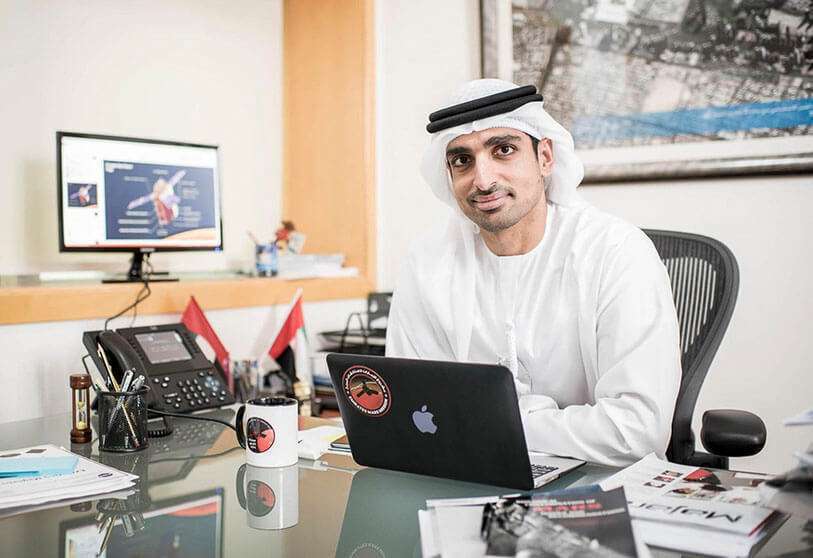The Emirates' Martian probe has already travelled over a million kilometres

The Emirates' Martian spacecraft Al-Amal flies through the cosmos under 24-hour supervision from the ground to check it is operating properly and is capable of reaching the Red Planet in February 2021.
Since its launch from Japan on July 19, at 23:58 Spanish peninsular time and throughout the seven days in which it sails alone on its way to Mars, it has already covered more than one million kilometres of the 493.5 million it has to cover. It now travels at 126,000 km/h, a hundred times the speed of sound if it were in the Earth's atmosphere. During this time it has undergone practically all the critical interventions of the Launch and Early Operations Phase or LEOP, which will continue for another week.
The LEOP campaign also falls to Mitsubishi Heavy Industries, which has not only been responsible for putting the Emirates' Martian spacecraft into orbit, but has also taken on the task of handing over control and monitoring of the probe to the Emirates authorities in full operational condition.

For this reason, since the separation of the probe from the launcher a few hours after take-off from the Tanegashima base, Mitsubishi engineers are checking that no components or equipment on board have suffered any kind of damage that would prevent it from fulfilling its task of guiding the spacecraft to Mars and, later, to put into operation the three scientific instruments that travel inside it.
Using orders sent as remote controls to the tracking stations in Masuda, Okinawa and Katsuura, the Japanese technicians have turned on the onboard equipment one by one to check that it is working properly, that sensors are not giving false measurements and that there are no leaks in the fuel tank.

They have given the instructions to orient and maintain the solar panels towards the sun at all times to keep the batteries that run the onboard systems permanently charged. They also check continuously the temperature of the equipment to keep it in its correct range. Sequentially, they open and close the valves of the thrusters that must be turned on to increase or decrease the speed of the spacecraft as many times as necessary.
The technicians on the ground who receive the telemetry of the exact position of Al-Amal in space have also recalculated the optimal trajectory of the probe to follow its path to the Red Planet, have transmitted the data to the antennas so that they know the exact orientation towards which they have to point and have sent remote controls to reconfigure those onboard systems which require it.
Once the LEOP phase has been completed in one week, the Japanese technicians will transfer full responsibility for the Martian probe to the Mission Operations Centre at the Mohammed bin Rashid Space Centre in Dubai, and Al-Amal will then enter the cruise phase and continue at the speed of 126,000 km/hr.

Shortly before mid-August, Emirati controllers will make contact with the spacecraft "between two and three times a week, with a contact time of approximately six hours each time," confirmed project director Omran Sharaf, who said the interplanetary mission "has consumed several years of my life".
The probe will send scientific data to the University of Colorado's Atmospheric and Space Physics Laboratory, which will relay the information received to the Science Data Center - also located at the Mohammed bin Rashid Space Center - for dissemination to the international scientific community.

While the above-mentioned events are being completed, the personnel of the Emirates Space Agency and the Mohammed bin Rashid Space Centre who were deployed to the Japanese launch base in Tanegashima to supervise the take-off have returned to the Emirates.
Following the conclusion of their mission and the completion of the work and administrative documentation closing the launch of the first Arab interplanetary mission into orbit, the 30 technicians took two separate Etihad Airways flights at Tokyo-Haneda airport to the United Arab Emirates. A team of technicians led by the President of the Emirates Space Agency and Minister of Advanced Science, Sarah bint Yousif al-Amiri, arrived at Dubai airport, while the second team led by the Director General of the Emirates Space Agency, Mohammed Nasser al-Ahbabi, landed at Abu Dhabi airport.

Due to the COVID-19 coronavirus pandemic, the 30 Emirati technicians were organized in two teams to arrive in Japan before the spacecraft and cooperate with Mitsubishi personnel in the reception operations, verification of its status and integration in the H-IIA rocket.
The teams travelled on April 6 and 21 and were subjected to mandatory checks by the Japanese health authorities and were forced into quarantine for 14 days before being allowed access to the Tanegashima space facility.

President Khalifa bin Zayed al-Nahyan is confident that Al-Amal will reach Mars orbit in February 2021 to commemorate the 50th anniversary of the founding of the Union of Arab Emirates. For the moment, he is satisfied that the launch has been "a day of glory" and the work of the country's "brilliant and highly qualified minds".








